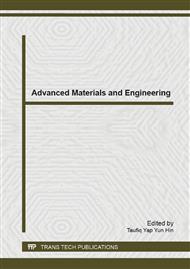[1]
C.G. McKamey, P.F. Tortorelli, J.H. DeVan, and C.A. Carmichael, A study of pest oxidation in polycrystalline MoSi2, J. Mater. Res. 7(1992) 2747–2755.
DOI: 10.1557/jmr.1992.2747
Google Scholar
[2]
A.A. Sharift, A. Misra, J. J. Petrovic, A. Misra, T.E. Mitchell, Alloying of MoSi2 for improved mechanical properties, Intermetallics. 9(2001) 869–873.
DOI: 10.1016/s0966-9795(01)00084-x
Google Scholar
[3]
P.J. Meschter, Low temperature oxidation of molybdenum disilicide, Metallurgical Transaction. 23(1991) 1763–1722.
Google Scholar
[4]
T.C. Chou, T.G. Nieh, Kinetics of MoSi2 pest during low-temperature oxidation, J. Mater. Res. 8(1993) 1605–1610.
DOI: 10.1557/jmr.1993.1605
Google Scholar
[5]
K. Kurokawa, H. Houzumi, I. Saeki, H. Takahashi, Low temperature oxidation of fully dense and porous MoSi2, Materials Science and Engineering. 261(1999) 292–299.
DOI: 10.1016/s0921-5093(98)01078-8
Google Scholar
[6]
K. Ramasesha, K. Shobu, Oxidation of MoSi2 and MoSi2-based materials, Bull. Mater. Sci. 22(1999) 769–773.
DOI: 10.1007/bf02745603
Google Scholar
[7]
P.Z. Feng, X.H. Qu, I.S. Humail, X.L. Du, Low-temperature oxidation behavior of MoSi2 powder, J. Univ. Sci. Techno. 14(2007) 558–561.
Google Scholar
[8]
D.B. Lee, Oxidation features of SiOC/MoSi2 composite at low temperatures, METALS AND MATERIALS International. 10(2004) 413–147.
DOI: 10.1007/bf03027317
Google Scholar
[9]
H.M. Hong, G.Q. Liu, L.R. Xiao, D.Q. Yi, L. Zeng, Low temperature oxidation behavior of MoSi2 composites strengthened and toughened by Si3N4 particles and SiC whiskers, Journal of Inorganic Materials. 24(2009) 929–933.
DOI: 10.3724/sp.j.1077.2009.00929
Google Scholar
[10]
H.A. Zhang, H.J. Wu, S.Y. Gu, Preparation and properties of MoSi2 based composites reinforced by carbon nanotubes, Ceramics International. 39(2013) 7401–7405.
DOI: 10.1016/j.ceramint.2013.02.083
Google Scholar
[11]
Y.Q. Liu, G. Shao, P. Tsakiropoulos, On the oxidation behaviour of MoSi2, Intermetallics, 2001, 9: 125-136.
DOI: 10.1016/s0966-9795(00)00114-x
Google Scholar
[12]
T. Futatsuki, T. Oe, H. Aoki, N. Komatsu, C. Kimura, T. Sugino, Low-temperature oxidation of SiC surfaces by supercritical water oxidation, Applied Surface Science. 256(2010) 6512–6517.
DOI: 10.1016/j.apsusc.2010.04.039
Google Scholar
[13]
S. Kawasaki, T. Oe, N. Anjoh, T. Nakamori, A. Suzuki, K. Arai, Practical Supercritical Water Reactor for Destruction of High Concentration Polychlorinated Biphenyls (PCB) and Dioxin Waste Streams, Process Safety and Environmental Protection. 84(2006).
DOI: 10.1205/psep.05187
Google Scholar
[14]
H.A. Zhang, S.Y. Gu, On the oxidation behaviors of MoSi2 at 673– 873 K, Advanced Materials Research. 284–286(2011) 1630–1634.
DOI: 10.4028/www.scientific.net/amr.284-286.1630
Google Scholar


